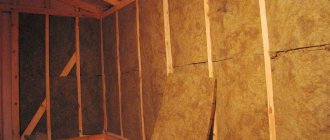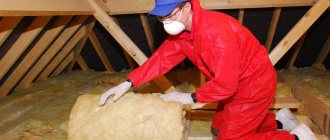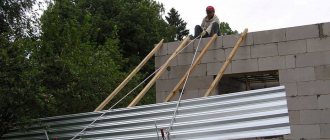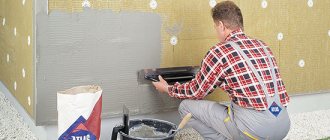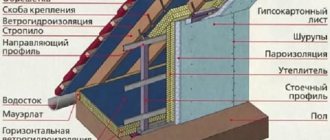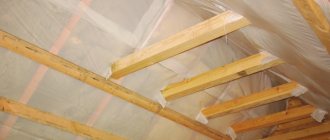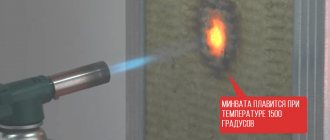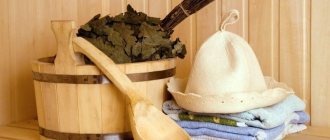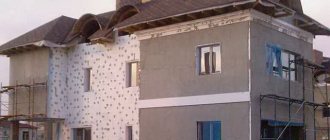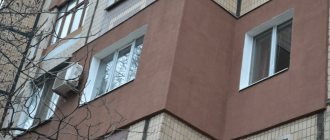External garage roof insulation technology
Since the room itself is not always heated, it is extremely important that the material itself retains its insulating abilities at any room temperature. An equally important point concerns machine exhausts and vapors from fuels and lubricants, which accumulate on roofing insulation over time and can reduce their fire resistance.
That is why it is worth choosing mineral wool or fiberglass as insulation. If the installation of the insulating layer will be carried out in the garage with your own hands, it is worth considering the option of foam insulation or polystyrene foam, which are easy to use. These same materials are resistant to possible deformation and retain their original elasticity throughout their entire service life.
Insulation of the ceiling in the garage
If the garage is equipped with a single or double slope roof, then it is much easier to ensure that the roof does not leak.
But what to do if the roof is flat and made of a concrete slab? But there are a lot of such roofs on garages. And often when buying a garage you don’t have to choose, since if you refuse it, the car will have to “sleep” on the street all the time.
When starting to waterproof a flat roof, it is better to combine this process with insulating the ceiling.
The roof and ceiling here will form one whole. It is better to choose extruded foam as insulation, as it has good mechanical strength and is very resistant to compression. And for the roof above you can buy Kharkov roofing felt or even Euro roofing felt.
When the concrete slab below is prepared and cleaned of dust and dirt, a frost-resistant primer is first applied to it. But it should only be of deep penetration.
The foam is attached with a special glue and fixed using a device called an “umbrella”. There should be a small gap between all sheets of foam on all sides, which is subsequently filled with polyurethane foam. Due to this, thermal insulation will become more reliable.
A cement-sand screed should be applied on top of this insulation, the thickness of which should be 3-4 cm, and only after this can you begin waterproofing the roof.
To do this, the top of the concrete surface should be thoroughly cleaned and coated with a primer, or a special bitumen-polymer mastic should be used. This mastic is sold in construction stores. But before use, you should read the instructions, since it is applied to different materials differently.
Internal location of insulation
When figuring out how to insulate a flat roof from the outside, do not forget that insulation can also be done from the inside. This solution is especially relevant if there is an unused or technical attic space. In this option, all the necessary materials are attached to the ceiling from the inside. However, this does not relieve the need for external waterproofing.
This method of insulation is less effective than external insulation, but in some cases it may be the only possible one. Here, all the components of the structure and their arrangement will correspond to classic external insulation, with the only difference being that they will be located not from bottom to top, but from top to bottom, in the reverse order.
The only difference is the creation of a heat-insulating structure in residential premises, when the outer side of the assembled pie will act as a ceiling. In this case, the external component of the assembled “pie” will be a decorative coating. This can be either a suspended ceiling or any other solution that is more suitable in appearance or suits the taste of the owner of the house.
Do-it-yourself garage insulation: tips and tricks
Although the garage is not a living space, it also needs insulation. This is especially true for unheated garages.
Insulation is necessary, first of all, so that the car functions normally while in the garage in winter. In addition, if you need to spend time in the garage in winter, it is much more pleasant to be in an insulated room.
Let's look at the types of materials for garage insulation and the technology for their installation below.
- Reasons for insulating a garage
- A set of measures for insulating a garage with your own hands
- Insulation of the garage inside and out: materials
- Garage roof insulation technology
- Do-it-yourself insulation of a metal garage
- Expanded polystyrene - do-it-yourself garage insulation
Reasons for insulating a garage
Most often, during the construction of garages, fairly thin walls are installed. This allows you to save consumables. A metal garage has very thin walls and in order to heat it in winter, you need to spend a lot of time and electricity.
Therefore, in order to make you and your car comfortable in the garage in winter, you need to think about insulating it. There are certain requirements for the temperature conditions for storing a car during the winter season. The minimum temperature of the garage room should be five degrees Celsius.
It is almost impossible to achieve such a temperature in metal garages without insulation. In addition, the room must have a ventilation system that supplies the room with fresh air from the street. Therefore, the air in the garage is constantly updated.
If you don’t take care of insulating the garage, but just heat it. This will create a greenhouse effect that will gradually destroy the car. For example, if the temperature in the garage in winter is +15 degrees, then the constantly entering air gradually cools the car and condensation masses form on it.
They accelerate premature corrosion of the car.
The ventilation system is a very important part of the normal functioning of the garage. If you seal a garage vent, carbon monoxide may accumulate in the room, and there is also a risk of mold and mildew forming on the walls of the garage.
Therefore, in order to always have a healthy microclimate in the garage, you need to take care of its insulation. Thus, the service life of your car will also increase.
A set of measures for insulating a garage with your own hands
There are a huge number of materials that can be used to insulate a garage. They differ primarily in thermal conductivity. So, comparing cinder block and polystyrene foam, you can make sure that the first transmits heat 15-17 times faster than the second. That is, one wall made of cinder block, 100 cm thick, has the same thermal conductivity as a 5-centimeter layer of expanded polystyrene.
Another important characteristic is thermal inertia. It indicates the change in temperature in the room after a certain time. That is, a cinder block wall will release heat or cold more slowly than expanded polystyrene. It will take longer to heat a solid wall than to heat an insulated coating.
Thermal insulation of a flat roof, which materials to choose
Recommendations for choosing material are the same as for any other design. For these purposes, basalt wool or extruded polystyrene foam is used. Let's look at their features
Insulation of a flat roof with mineral wool:
- Environmentally friendly product
- Permits steam and allows the roof to breathe
- Good thermal insulation
- High density, can be laid to suit the surface being used
- Fire safety, does not burn, does not melt, does not emit harmful substances
- Heavy weight, you must initially calculate the load
- Hygroscopicity, if the waterproofing is damaged, it will absorb moisture and lose its properties
- High price
Insulation of a flat roof with polystyrene foam
- Light weight, easy to install, transport, does not increase the load on the foundation
- Low price
- Not susceptible to moisture
- Good thermal insulation
- This is artificial material
- Burns or melts, in most cases does not meet fire safety requirements
- Does not allow steam to pass through
More often, basalt wool slabs are still used to insulate a flat roof. Since this is a more reliable and durable method. Also, this allows you not only to insulate rooms from the cold, but also saves you from heat in the summer, which cannot be said about other materials. And thanks to vapor permeability and the fact that the slabs are made from natural raw materials, a favorable microclimate is created indoors.
How to choose the right material?
Expert opinion
Konstantin Alexandrovich
You can insulate a garage roof using various materials. Each of them has its own characteristic advantages and disadvantages.
Below we will look at some of them in more detail:
Fiberglass
Such fiber is produced from waste and remains from the main production and use of glass products from glass factories: broken glass is first melted, then pulled into long bundles of threads, then cut into pieces and sharply cooled. After all the work done, a very thin fiber is obtained, which is sold either in the form of rolls or in the form of pressed slabs.
Due to the structure of the finest fiber threads, this material has extremely low thermal conductivity (does not allow heat to pass through). Its other properties are similar to those of simple glass: it is not highly flammable, and is not susceptible to moisture accumulation and destruction in an aggressive environment.
The disadvantage of this material is its fragility; it should not be subjected to mechanical stress, as it can crumble. In addition, when installing this type of material, one should not forget about safety rules: protective suit, gloves and goggles, as well as respiratory protection. Glass chips can easily damage the skin, and after this, medical intervention may be required.
You should be careful when selecting and purchasing fiberglass. Make sure that the packaging has not been opened, otherwise this may lead to the insulation spilling out and moisture entering it, which will subsequently reduce its effectiveness.
Mineral fiber
Mineral fiber (mineral wool) is similar in structure to glass fiber, but is made from a completely different material. The raw materials for this type of insulation are basalt rocks. The technology for producing mineral fiber is also similar: first, basalt is melted, then drawn out and thin fibrous threads are formed.
Two roofing pie recipes
The main difference between the two methods is the space occupied by the waterproofing material. In a classic roof, it crowns the entire structure, and in an inversion roof it is placed under the insulation, acting as protection for the floor slab, and not for the heat-saving layer. That is why mineral wool is not the most suitable place here - the fiber board will have to be carefully protected from atmospheric moisture.
Classic roofing (order from bottom to top):
- Vapor barrier from inside the room, if necessary.
- Concrete floor slab (it is possible to install a roof on top of rafters laid parallel to the base)
- Slope-forming cement screed or PENOPLEX layer mounted at an angle of 2-4% on stops (cut from the same material) or PENOPLEX SLOPE
- Insulation in one or more layers (in a checkerboard pattern). The manufacturer recommends laying a special separating material under and on top of the slabs.
- Waterproofing is most often a durable polymer roofing material. For the option of laying directly on PENOPLEX, a roofing membrane, for example, Plastfoil, is excellent.
This “pie” option is interesting if you are not going to use the flat roof space. The classic roof is just a roof. It is much more profitable to complicate the installation stage a little, but in the end get a durable and functional space. To do this you need an inversion roof (order from bottom to top):
- Concrete floor slab or rafters
- Slope-forming cement screed or PENOPLEX SLOPE
- Waterproofing membrane.
- Geotextile layer.
- Insulation in one or two layers (in a checkerboard pattern).
- Anti-root layer made of geotextile.
- A ballast layer of gravel - it “presses” the layers against each other, preventing them from moving. In the case of a green zone, it also performs a drainage function.
- (Optional) filtration layer.
- (Optional) soil layer.
Here is a version of the very popular “green” roofing all over the world. But the soil layer can be replaced with ceramic tiles or decking boards.
In this case, the heat-saving material also serves as a load-bearing material; it bears the main load from the equipment that will be placed on the roof, from the weight and active movement of people, the impact when some objects fall on the surface and, of course, the atmospheric load. PENOPLEX is perhaps the only available material that is capable of this.
Insulation technology
In private construction there are several types of roofs. But the main, basic ones are pitched roofing (has several varieties), mansard and flat. All possible types of roofs are shown in Fig. below.
Types of roofs.
Each of them has its own insulation technology.
Insulation of pitched roofs (from the inside)
How to insulate a roof with foam plastic from the inside? Thermal insulation of a pitched roof on a deck mounted on top of the rafters is considered to be carried out correctly. All work is performed in the following sequence:
- Glue is applied to the foam sheet in a snake or along the perimeter in a continuous strip. This can be polyurethane foam or polyurethane-based adhesive. A large amount of adhesive is not required, since the insulation does not experience significant vertical and horizontal loads;
- the insulation is glued to the flooring. The work is carried out from the bottom up, in an orderly manner;
- all gaps are sealed with thin sheets of polystyrene foam or polyurethane foam;
- the insulating layer is covered from top to bottom with a vapor barrier membrane type A (AM). It is laid with an overlap. It does not stretch either vertically or horizontally - it can burst in cold weather. It is attached to the sheathing with a stapler, but without fanaticism, because... The main fixation will be the counter batten slats. The seams are taped;
- the counter-lattice is stuffed. Here you need to abandon long slats. It is better to fill 2-meter ones, leaving gaps between them in the middle of the roof and at each edge of about 5-6 cm. They are needed for free air ventilation over the entire surface of the slope;
- the eaves overhang is insulated from the attic side;
- with such insulation, the dew point moves to the back side of the flooring. To protect the wood from condensation, the rafters and flooring are covered from below with plastic film or vapor barrier material.
Attention: many experts recommend covering the flooring with roofing felt or other rolled waterproofing material. The purpose of such work is not clear, because roofing material is vapor permeable, and condensation forms from the bottom of the flooring from moist air coming from the house.
Roofing material is attached to horizontally nailed slats.
Insulation of the attic roof
Let us immediately warn you that polystyrene foam cannot be used to insulate the attic roof. This is a direct prohibition of the Stockholm Convention. The explanation is simple: in the summer the roof gets very hot, resulting in an intense release of styrene, which is not excreted from the body, but accumulates in the liver.
It is difficult to ensure intensive ventilation of the attic space. Therefore, the editors of the StroyGuru.Com website do not provide information on attic insulation with polystyrene foam. For those who want to learn from the mistakes of others, we have prepared an article about insulating an attic with mineral wool, “Technology for insulating a roof with mineral wool.”
Flat roof (outside)
The procedure for insulating a flat roof is as follows:
- Sheets of foam plastic are placed tightly on the prepared base. No need to attach. If desired, you can glue it with special glue or fix it with special dowels. You can see how to do doweling in the article “Wall insulation with foam plastic”;
- After completing the laying of foam plastic, the seams are foamed, after which the entire surface must be covered with a vapor barrier film.
Further, the process of insulating the roof with polystyrene foam branches out.
- The garage roof is covered with 2 layers of waterproofing material.
Flat roof with soft roof.
- The roof of a residential building can be completed in the same way. But it is not done for design delights, but with a specific purpose. Therefore, its active exploitation is envisaged. To do this, expanded clay is poured onto the covered polystyrene foam, flat slate is laid on it in two layers or a cement-sand screed is poured onto it. When using polystyrene foam PPS-25 (PSB-S-35), you can do without expanded clay. You can lay OSB or flat slate boards directly over the insulation.
How to insulate a concrete roof with your own hands
To prevent condensation, it is necessary to protect cold concrete structures from warm air, which contains a lot of moisture. When the air cools, moisture vapor precipitates in the form of condensation. Insulation of reinforced concrete slabs can be done inside and outside, but the stages of work, types of thermal insulation and finishing materials will differ. Let's look at insulating a flat concrete roof step by step.
How to insulate a concrete roof from the outside
The structure of a sandwich panel with polystyrene foam insulation
The simplest and most reliable way to insulate a flat roof from the outside is to use sandwich panels. As can be seen from the photo, such a panel consists of two sheets of galvanized or painted corrugated board, between which there is polystyrene foam. On the one hand, sandwich panels are reliably protected from moisture and mechanical damage and can withstand heavy loads, and on the other hand they have low thermal conductivity.
Laying sandwich panels will require the use of construction equipment, which will significantly increase the cost of the work. A simpler option, when you can insulate a concrete roof yourself, is to use expanded polystyrene with roll waterproofing, for example, roofing felt. This technology is shown in the video at the end of the material. Such insulation of slabs can last for many years, the main thing is to check the waterproofing.
How to insulate a concrete roof from the inside
Photo. How to insulate a concrete ceiling and ceilings with foam plastic
It will be much easier and cheaper to insulate this structure from below, provided that you do not have to dismantle the expensive finishing on the ceiling. The easiest and most inexpensive way to insulate any surface is to use foam boards, despite the fact that it is a highly flammable material. If you plan to sheathe the ceiling in the future, this will not be a serious problem, especially if you use plasterboard sheets for finishing.
You can use non-flammable basalt thermal insulation, but attaching it to the ceiling will be much more difficult. It will be necessary to make an additional frame from profiles, as well as protect the mineral wool with a vapor barrier. In the video at the end of the article, we have selected a video clip for you, where one of the craftsmen shares his method of insulating a concrete garage roof from the street, using polystyrene foam boards, plywood sheets and roofing felt for thermal insulation.
Roof insulation
In addition, if the roof is insulated, thoroughly waterproofed and provided with effective ventilation, this will allow, in addition to effective energy saving, to expand the living area of the room due to the resulting attic, which can be made as cozy and comfortable as all other rooms.
If the roof is located above a non-residential attic and consists of rafters, sheathing and roofing, then insulation is not always necessary. The attic is continuously ventilated, and the temperature and humidity in it are almost the same as the outside air. In such houses, the main thing is to carefully insulate the attic floor.
But if under-roof thermal insulation is installed, the temperature and humidity of the air inside the attic floor differ significantly from the air outside. Moisture rises along with the warm air and comes into contact with the colder, lower surface of the roof. This causes condensation to form on it. Also, moisture can penetrate into the roof elements, which is facilitated by inaccurate laying of the vapor-proof layer on the inner surface of the insulation, insufficient overlap of the vapor barrier strips, their loose fit to the walls and pipes, accidental ruptures, etc. Therefore, first of all, when insulating the roof, you need to take care of the device reliable vapor barrier located on the interior side. On the roof side, the insulation is protected by a layer of waterproofing laid along the rafters or a special flooring.
Such protection of an insulated roof on both sides is quite reliable, but sometimes this is not enough. It is necessary to provide a way to remove moisture that accidentally gets into the insulation. This effect is achieved by air circulation in cavities, one of which is located between the roof and the under-roof waterproofing, and the other is located between the under-roof layer and the thermal insulation layer. In order for outside air to freely enter these cavities and be removed from them just as easily, it is necessary to install vents in the roof overhang and in the upper part of the roof. To ensure free movement of air between the roof and the under-roof waterproofing, lay counter battens along the rafters. Their thickness determines the size of the air cavity. Air enters this cavity through holes located in the side overhangs of the roof.
How to avoid the problem of high humidity
After thermal insulation work, the humidity inside the room may increase, which negatively affects the microclimate. There are several reasons for this.
- Insulated structures have gaps or cracks, which means their integrity is compromised. Therefore, before starting work, it is necessary to carefully check all the bases and eliminate all existing defects in advance.
- There is no vapor barrier layer or it is damaged. In this case, moisture does not leave the room, but accumulates in the insulating material. Therefore, it is imperative to use a vapor barrier film, gluing the joints of the sheets with a tape specially designed for this.
- The system of natural and forced ventilation of the room was broken. For example, during the renovation, the ventilation holes were moved or blocked, the shaft was blocked, and metal-plastic windows were installed. All of the above actions lead to a decrease in air circulation due to excessive tightness of the structure, so it is necessary to periodically ventilate the room or take care of installing supply and exhaust ventilation.
Outdoor installation
With this approach, all layers of insulation and waterproofing are located on the outside of the ceiling. Accordingly, it is necessary to create a heat-saving “pie” that can withstand all temperature and climate changes. There are two main types of flat roofs, insulated differently:
A classic roof is insulated according to a standard scheme and the layers are laid in the following order, counting from bottom to top:
- Floor slab
- Vapor barrier film
- Insulation
- Waterproofing
This scheme has a significant drawback - external waterproofing requires periodic maintenance and repair. It is produced every two to three years and this entails additional costs, although such a roofing device is slightly cheaper than the other option - the inversion one.
This type of roofing is considered more expensive to install, but it withstands temperature changes better and does not require such frequent repairs. Its fundamental difference from the classic version will be a different scheme for laying layers and arrangement:
- The first will be, as in the previous case, the floor slab
- Then - screed
- Next comes waterproofing
- Next is insulation
- A special film is placed on top - a filter.
- Cover the pie with expanded clay or gravel, at least 50 millimeters thick
This solution allows you to protect the waterproofing gasket and significantly increase its service life.
Insulate the garage roof outside and inside: instructions and features
The function of a garage is to protect. A good-quality room serves as a shelter for the precious “swallow”. Cold, dampness, moisture, temperature changes, condensation are the enemies of your garage, and, consequently, of your car.
In this case, he himself needs proper care, and the best place to start is with shelter. The first step in arranging a room is insulating the roof.
How to insulate a brick garage roof
Fiberglass provides low thermal conductivity due to its fibrous structure. The material is made from glass, which is melted and drawn into thin threads. Fiberglass does not burn, does not decompose or rot. However, the material should not be subjected to mechanical stress. During installation, you should work in personal protective equipment so that fiber particles do not get on the mucous membranes and skin.
Mineral wool (basalt) insulation resembles fiberglass in structure, but differs in the source material (basalt rocks). Mineral insulation is a more plastic and elastic material. If installed correctly, the insulation will last for decades. But during installation, the mineral wool should be protected with a vapor barrier from moisture and finishing from mechanical damage.
Expanded polystyrene is very popular due to its ease of installation and low cost. All polymer insulation materials are manufactured using the same technology - the porous structure of polystyrene foam allows them to retain heat for a long time. Technoplex does not absorb moisture and withstands significant mechanical loads, but polystyrene foam is afraid of direct sunlight and is flammable.
Review of popular insulation for garage roofs
Let's take a closer look at what types of insulation we know and why they are good.
Glass wool
Glass wool
It is not for nothing that it is first on the list, because it is the most popular on the market for the purpose of insulating a garage. Its properties allow you not to worry about it deteriorating, becoming infected with fungus, starting to decompose due to the influence of moisture and condensation, and will not cause a fire. The thermal conductivity coefficient of glass wool is 0.031, and, for example, that of the same stone wool is 0.035, which is insignificant, but different and conducts more cold into your garage than glass wool will. It is unlikely to harbor insects and is one of the most affordable in terms of price. It is sold in blocks. But you can also buy it in a roll. Unfortunately, this insulation has its drawbacks. For example, it is unsafe if it comes into contact with the skin, eyes, nose and mouth. If such a problem occurs, then you need to immediately go to the doctor, otherwise it promises suppuration on the skin and problems with the eyes.
Expanded polystyrene (or polystyrene foam)
Foam plastic for roof insulation
This type of insulation is the most popular for insulating apartments in high-rise buildings. But it's just as good for the garage. One of its best qualities is that it does not absorb moisture at all, has minimal thermal conductivity - a thermal conductivity coefficient of 0.043. This coefficient, as you have noticed, is greater than that of stone wool, and we will talk about it below. While we easily list the pros, do not forget that this material also has its cons. For example, it is easily flammable, as well as the fact that its structure can be easily disturbed by various rodents and insects, which often settle there as a whole flock and breed. This, at a minimum, spoils your thermal insulation, and, at a maximum, is the reason for calling disinfectants.
Stone wool
Stone wool mats are laid between the roof rafters
This type of insulation also belongs to mineral wool, but at the same time, its thermal insulation is worse than glass wool. This type of insulation is just as good as glass wool - it suppresses noise well and is completely waterproof. Therefore, it is really worth recommending for insulating a garage roof.
Penoizol
Liquid penoizol is the most modern material for roof insulation and more
This is a relatively new and very effective insulation. It is very convenient to work with: it is applied to the surface in liquid form, after which it quickly hardens, filling all joints, crevices and cracks. It is characterized by fire resistance and does not absorb moisture. The service life of penoizol is from 50 to 70 years. The only drawback is the high price and the need to use specialized equipment for spraying the material.
Why insulate a flat roof?
Having dealt with the main issues, let us summarize the need to carry out this rather complex and expensive work. As mentioned above, this design is used mainly for non-residential buildings or similar apartment buildings. In private housing construction there is no need for it. Not only does such a structure weigh more than a classic pitched one, but it also poses difficulties with water drainage. Its only advantage is the low cost of polymer-bitumen roll materials, but this is offset by expensive insulation.
So, why do you need thermal insulation for a flat roof:
- Retaining heat in winter and maintaining a comfortable temperature in summer, this is especially true if there is no technical floor
- Savings on heating and air conditioning, as a consequence of the previous point
- Multi-layer coating virtually eliminates leaks
- Elimination of condensation accumulation and, as a consequence, extension of the service life of the roofing covering
How to insulate a garage roof with your own hands
When insulating the roof internally, we advise you to pay attention to mineral insulation. This insulation does not support combustion, but requires additional protection with a vapor barrier film
The best option for roof insulation is thermal insulation of the garage roof with mineral wool at the construction stage, as in the case of independently insulating an attic with mineral wool from the inside.
How to insulate a pitched garage roof
Technoruf is a modern material that is used as a top layer for thermal insulation of pitched roofs. The material is not flammable, it can be used without loss of characteristics at temperatures from -60 to +400°C. The use of waterproofing when laying Tekhnoruf mineral wool is mandatory. All brands of Tekhnoruf mineral wool are characterized by high density and low thermal conductivity.
https://youtube.com/watch?v=rfVVA284DP4
How to insulate a garage roof from the outside
It is quite difficult to insulate a garage roof from the street so that it lasts for a long time. Therefore, manufacturers offer different solutions to this problem every year. A layer of polystyrene foam or mineral wool insulation for external thermal insulation is located between the roofing and the reinforced concrete slab, but the material should be protected from mechanical damage and moisture.
When insulating a garage roof, you should strictly follow the sequence of laying materials. To begin with, a hydrobarrier, a heat-insulating layer and a vapor barrier are laid. If the ceiling is a reinforced concrete slab, then the thermal insulation materials are attached directly to the roof. Mineral wool is characterized by fire safety and high heat-saving ability and sound absorption.
Expanded polystyrene can be fixed to a flat roof from the outside or inside using dowels. The seams between slabs of foam plastic or extruded polystyrene foam should be foamed. It is advisable to lay expanded polystyrene slabs in two layers in a checkerboard pattern so that the second layer overlaps the seams of the previous layer. Thus, you will reduce the risk of cold bridges in the thermal insulation layer.
How to insulate a garage roof from the inside
When laying thermal insulation internally, you should first treat the wooden floors with an antiseptic and the reinforced concrete slab with mastic. Installation of polystyrene foam on a concrete roof slab is carried out using mounting foam with additional fastening using disc dowels. For single-pitch and gable roofs made of wood, slab insulation is laid between the rafters, and all seams are foamed.
To lay mineral wool, a frame should be built on the ceiling. Many manufacturers produce slabs of increased rigidity that are easily inserted between the rafters. If rolls or slabs of low-density mineral wool are used, then insulation should be laid on the roof lining. After laying the mineral wool, it should be protected with a vapor barrier membrane from moisture penetration.
In the video at the end of the material, you can take a closer look at the entire technology of the work. Let us remind you that when insulating a garage, ventilation of the room should be provided. The fact is that in a warm and humid room the car will begin to rust faster. Don’t forget to also properly insulate the garage door, since most of the heat escapes through this structure in the winter.
Instructions for insulating a garage roof from the outside and inside
Many experts believe that it is necessary to insulate the roof in the garage both outside and inside. But this approach is necessary for those places where winter temperatures are -20°C or more. Simply because in order to repair your car, you will need to be in the garage, and in such cold weather you won’t even be able to hold a wrench in your hands. For countries where the cold is not so severe, you can get by with single-layer insulation: choose a coating for insulation either from the outside or from the inside. But keep in mind that all these thoughts should come to mind before building the garage. If the garage has already been built, then there is no need to talk about any insulation from the outside, because dismantling the roof is extra work; in this case, it is much easier to carry out insulation from the inside.
Advice. Please note that the insulation used to cover the outside of a garage is different from those used to insulate the inside.
Technique for insulating a roof from the inside
If the roof is already laid, you can still insulate it, but only from the inside. For such insulation you will need patience, because you will have to dismantle the entire inner layer (whitewash, drywall, plywood) to get to the layer with the rafters.
The garage roof is insulated from the inside already during operation, when
Basically, to insulate the roof from the inside, isover, polystyrene foam or penoizol are most often used. These are the best options because they are convenient to attach from below, and penoizol is applied by spraying.
- Waterproofing film. When you reach the rafters, you need to install a waterproofing film between them, which will prevent moisture from getting on the insulation.
- Insulation flooring. We have already talked above about which insulation materials are most popular for covering the inside of a garage. We will talk further about polystyrene foam, because it is considered the most popular product that is purchased for insulating the roof of a garage from the inside. It is easy to work with because you can simply glue it to secure it to the roof. However, not all types of glue may be suitable for this. Many can simply split the foam structure, and you will simply ruin them, so we advise you to find out all the necessary information about this in advance. Advice. To work with polystyrene foam, you need to use glue that does not contain acetone, ether and gasoline. For example, a popular adhesive for polystyrene foam: adhesive MONTAZH express Moment 600 618
- A vapor barrier membrane is placed over the insulation and secured to the rafters using staples or adhesive tape.
- Next, you can cover the inside of the roof with decorative material: plasterboard, wood, etc.
Video: how to inexpensively insulate a garage ceiling with foam plastic
External roof insulation technique
When carrying out external insulation, you need to make sure that nothing will create secondary condensation, and for this you need waterproofing. If there is waterproofing, then you can proceed to the next step. But if there is no such insulation, then you should deal with it first, and only then with insulation. Otherwise, there will be no point in insulation.
The insulation is laid during the roof construction stage. The insulation is installed when the rafters have already been laid and the roof is still uncovered. From the point of view of building codes, laying insulation on the outside is a more sanctioned and technically correct action.
Diagram of an insulated garage roof
So, how to lay insulation outside:
- Installation of a vapor barrier membrane. It is attached to the slings with small slacks. It is secured with construction staples. The vapor barrier membrane must be installed so that there is not a single gap between the rows, otherwise its entire effect will be nullified, because it must protect the garage from moisture. You also need to be careful. None of the membranes should be torn or otherwise damaged.
- Installation of sheathing. It should be installed in increments equal to the width of your insulation. This will allow you to securely fasten it and avoid many problems with fixing the insulation.
- Fastening the insulation. It is placed on top of the sheathing. You should try to avoid cracks. Advice. If there are still cracks during the installation of polystyrene foam, then it is necessary to fill them with polyurethane foam. In all other cases, the joints must be sealed using any method known to you.
- Waterproofing film. Its purpose is to prevent precipitation from getting on the insulation. Therefore, the entire operation must be carried out as carefully as installing a vapor barrier membrane. In the area of joints, it is best to seal the waterproofing film with construction tape.
- Roof. After all the above steps, you can install roofing materials. Your roof is now securely protected!
Video: method of insulating a garage roof with Ecotermix material
How to insulate a concrete roof of a garage or house
Externally, you can use polystyrene foam and mineral wool slabs of increased rigidity, for example, Tekhnoruf from the well-known company TechnoNIKOL. External insulation of a concrete roof is preferable when the ceiling has been finished inside the room and additional costs will be required for dismantling and installing the finishing. In addition, high-quality waterproofing of the insulation will be required, since it will be exposed to moisture all year round.
Photo. Scheme for laying mineral wool slabs on a flat roof
If waterproofing is properly installed on the outside, then work can be done from the inside. In this case, you can use cheaper mineral wool with a lower density, as well as foam boards. Please note that carrying out work inside is accompanied by a loss of some ceiling height in the room. And mineral wool needs to be additionally protected with a vapor barrier membrane from moisture contained in the air.
Is it possible to insulate a garage with foam plastic from the inside?
The foam insulation is overlapped.
Can foam plastic be used indoors? How to properly insulate a garage ceiling using this thermal insulation? According to experts, polystyrene foam can be used indoors if it is made of brick, foam blocks or metal. There are times when a garage is built from wood. Polystyrene foam interferes with the air exchange of wood. Subsequently, it may rot.
The insulation of a garage roof with foam plastic from the inside is carried out as follows (the material is laid from top to bottom):
- sheathing;
- waterproofing;
- insulation;
- vapor barrier;
- fine finishing.
The foam sheets should fit tightly between the joists.
The lathing can be metal or wood. There is waterproofing on top of it. If a special material such as geotextile or isospan is used, then installation is carried out according to the instructions. The film should run across the roof rafters, with the smooth side facing out. Sagging of the hydraulic barrier is allowed. There should be a ventilated gap between the film and the sheathing. To do this, the rough roof covering is covered from the inside with thin wooden slats.
Foam plastic slabs are laid between the lathing slats without gaps. For installation, special glue and anchors with wide caps are used. In some cases, the insulation is fixed using auxiliary slats. They are attached to the beams of the main sheathing in increments of 20-30 cm. Such sheathing will later serve as a second ventilation gap.
To insulate the ceiling in a garage with foam plastic without the formation of cold bridges, you need to be careful about the quality of the thermal insulation material. Only certified products have dimensions with minimal error, which guarantees a tight fit of the slabs.
A vapor barrier film is laid on top of the insulation. If necessary, at this stage you can improve the sound insulation of the building or lay down reflective thermal insulation. Finally, finishing is carried out.
How to insulate a flat roof
Let's say right away that the choice is limited. It’s not that there isn’t enough choice on the market, but in practice, most often only three alternatives are used. Let’s make a reservation right away: such a roof is not a place for mineral wool. It does not meet the requirements for rigidity, hygroscopicity, or ease of installation: it must be covered with a layer of concrete screed, and this puts additional load on the building, complicates and lengthens the construction cycle.
- Expanded clay or perlite sand. The only advantage of this option is the cost. These are the most affordable materials that have served as a heat insulator for centuries. However, having made such a choice, you will be forced to get out of a number of nuances. Firstly, if the slope is not set by a layer of sand-cement screed on top of the ceiling, it is simply impossible to form the required angle for moisture drainage using loose expanded clay or sand. Secondly, it is unlikely to be possible to achieve the same layer thickness over the entire roof surface. And this will directly affect the thermal conductivity of the finished roof. Thirdly, working with such material and covering it with subsequent layers is simply inconvenient; this prolongs the construction time.
- Foam glass. This type of insulation appeared relatively recently, so there is no need to talk about any established practice yet. It is made from broken glass: the raw material is heated in a furnace to 800–900 degrees, foamed by burning a gas-forming agent (coal), and then slowly cooled. The result is a durable material with a cellular structure. It is produced in the form of blocks, which are cut into small slabs.
Foam glass has proven itself well in the insulation of flat roofs of large areas - industrial premises, multi-storey buildings, and also as an insulator in the construction of swimming pools and buildings with difficult temperature conditions.
- low thermal conductivity coefficient;
- steam resistance;
- absolute incompressibility, which plays a significant role in commercial construction and equipment of exploited roofs;
- service life of at least 100 years;
- absolute resistance to moisture, chemical and biological influences;
- ease of installation - the slabs are laid on ordinary building mixtures.
But there are also significant disadvantages:
3. Extruded polystyrene foam. The undisputed leader in the issue of insulating the flat roof of any structure - from a garage to a giant workshop or a skyscraper with an equipped helipad. Many experts, when describing the technology for installing a flat roof, do not even consider other options. And this is absolutely justified.
EPPS, popularly “extrusion” or “penoplex” (a common noun from the most popular brand PENOPLEX), is the closest relative of construction foam. It is made from the same polystyrene granules, but using a different technology, which results in a rather thin, light, and at the same time durable and dense board with closed cells. Inside the cells there is a gas, which prevents the transfer of heat, as well as the conduction of noise. Of course, all these indicators directly depend on the quality of the material. It is not for nothing that the term PENOPLEX, and not some other brand, has become popular among the people - this is the largest production of EPS in Russia with stable quality.
Advantages of PENOPLEX for flat roofing:
- the lowest coefficient of thermal conductivity allows you to maximally protect the house from heat loss and insulate the roof from excess heat (this is precisely why waterproofing usually wears out: roofing felt is constantly subject to compression from the outside cold and stretching from the heat from the room);
- using slabs it is easy to form an even and stable slope;
- forms a monolithic thermal insulation contour without gaps, and therefore cold bridges (for this, the edge of the slab is given an L-shape);
- high strength and absolute moisture resistance make PENOPLEX an ideal basis for installing a used flat roof, and also allow you to save on vapor barrier;
- resistance to chemical and biological influences, as well as a wide range of operating temperatures allow the roofing pie to serve for at least 50 years;
- installation of PENOPLEX boards occurs quite quickly compared to other types of insulation.
The disadvantages of this material, which appear in other types of work, do not play a noticeable role in this case.
Therefore, we will consider the procedure for installing a flat roof using classical or inversion technology using the example of PENOPLEX.
Video description
So that you can understand how thermal insulation is carried out with polyurethane foam, we suggest watching the video:
So, having dealt with external thermal insulation, we move on to insulating the garage roof from the inside.
Thermal insulation of a garage roof from the inside
Typically, this option is used if the garage is already in use and has problems with condensation. Or the owner of the building suddenly decided to simply insulate it. Typically, one option is used for this - thermal insulation of the ceiling. And since this is most often a concrete slab, it will have to be insulated accordingly.
The simplest option is to use polyurethane foam. It is simply applied to the surface of the slab. After that, a synthetic plaster mesh is laid and plaster or putty is applied, which is subsequently painted. If a suspended structure is used in the plan, then first direct hangers are mounted on the floor slab, then the insulation itself is applied, and only then a lathing is formed on which the finishing material (slab, sheet, panel or slatted) is installed.
It is more difficult with thermal insulation, which uses slabs. To do this, first a frame of wooden blocks or metal profiles is assembled along the ceiling. And already between the frame elements they lay slab insulation. For example, the photo below shows how polystyrene foam boards are installed in a frame structure.
Insulating a garage roof from the inside with polystyrene foam boards Source pallcare.ru
As in all previous options, the main task is to lay the insulation so that there are no gaps or cracks between it and the frame elements. Therefore, it is very important to correctly trim the thermal insulation panels to the size of the frame cells.
It is important to choose the right thickness of the thermal insulation layer. For garage premises, this figure varies from 80 to 150 mm. That is, it is precisely this dimensional parameter that will lower the ceiling in the garage. This must be taken into account when choosing thermal insulation material. This does not apply to polyurethane foam, because it has the lowest thermal conductivity - 0.019 W/m K. Therefore, its thickness of 50 mm is sufficient.
Thermal insulation of a garage roof from the inside requires special attention to such a parameter as fire resistance. Therefore, if it was decided to use slab materials for insulation, then the ideal option is mineral wool. It doesn't burn. But the requirements for its installation are more serious. That is, it is necessary to cover it on both sides with waterproofing. And although the waterproofing films themselves are inexpensive, the process of installing them is not as simple as it might seem at first glance.
Expert advice on how to insulate a garage roof
A warm garage is one of the main factors determining the good “health” of a car. One cannot but agree with this, because the cause of condensation is sudden temperature changes. And condensation is the number one enemy of metal anti-corrosion protection and, naturally, can cause significant harm to the car. But how to insulate a garage roof, what material will be “warmer”?
The roof is the main component in the system of protecting any structure from adverse weather conditions. Therefore, it is not enough just to insulate it; it needs constant prevention from leakage, dampness, and other things. How to properly insulate a garage roof so that it performs its functions best. There is no need to “discover America”, as for any type of structure there are already specially developed building codes and regulations that indicate the optimal conditions for maintaining machines.
https://youtube.com/watch?v=NrbYylCqtLQ
The feasibility of insulating a garage
Finishing with natural lining over insulation.
Why do you need to insulate the ceiling in a garage? As you know, warm air is lighter than cold air, and therefore the first one always tends upward. When it encounters an uninsulated roof on its way, it quickly transfers part of its thermal energy to the ceiling, and then to the environment. A layer of thermal insulation material on the ceiling or roof will reduce the intensity of heat exchange between the interior of the garage and the street. Also read: “Basic methods of heating a garage with your own hands.”
On the other hand, the constancy of the microclimate in the garage preserves the car parts. Sudden temperature changes lead to the formation of condensation on the metal structural elements of the car. The latter begin to become corroded. Insulating the garage roof from the inside or outside will help maintain a constant temperature in the building. As a result, condensation does not fall out, and machine parts maintain their integrity.
Before making a potbelly stove with your own hands, calculate the diameter of the chimney - this is very important.
Read about which long-burning stoves are best for heating a garage here.
Flat roofing is correct and not
Flat roofing in Russia has a worse reputation. According to ordinary people, it must leak, because rain moisture and snow have nowhere to go compared to a pitched rafter roof. Water must certainly accumulate and test the strength of the waterproofing layer every second. And this means constant repairs, waste, effort, nerves...
Where does the stereotype come from? From the very recent past.
In the USSR, flat roofs were used in the construction of multi-story administrative and utility buildings, as well as residential buildings from three to twelve floors. Until now, in advertisements for searching for an apartment they write the sacramental: “Not the last floor,” because it is firmly entrenched in the mind that the roof will leak, the ceiling will get wet and turn black. Proven by practice. In those days, the issue of energy efficiency of buildings was not on the agenda, and therefore no one was particularly concerned about how to get rid of the disadvantages and turn them into advantages. Year after year they patched up roofing felt, whitewashed the ceilings, scolded the material, the hands and those who came up with the idea of building flat roofs, and that was all.
Meanwhile, already in those years it was possible to build truly aesthetic and practical roofs, including in the private sector. Moreover, such a roof has a number of advantages over pitched roofs:
- the final area is significantly smaller, which means the consumption of materials is also reduced;
- there is no need to erect complex rafter structures, and there is no need to ventilate the attic;
- it is easier to work on construction: all manipulations are carried out on a plane, and not at a serious slope;
- more convenient to use: you can walk on it, you can mount solar collectors, antennas, external air conditioning units on it, and also organize an additional recreational area - solarium, barbecue, even a swimming pool;
- there is no risk of snow melting, and there is no need to clear the roof of it: with the correct construction technology, the snow cover will become an additional heat-insulating layer, and in the spring it will melt and neatly flow in rivulets into, again, a properly organized drain;
- gives more options for architectural solutions.
Strictly speaking, a flat roof is not flat at all, it has a slight slope of 2 to 4% to drain water. The slope can be centripetal, then moisture flows from the edges to the center, like in a kitchen sink, and enters the internal drain pipe. Or there may be a reverse slope, when the edge of the roof is 2-4% below the central point, the ridge. Then rain or melt water goes into gutters and drainpipes located on the facade. Therefore, a properly constructed roof should not leak.
The second mandatory condition for a “correct flat roof”, which previously was not taken into account at all, is insulation. After all, from 30 to 40% of heat loss occurs through the roof: warm air collects under the ceiling, and if it does not meet a barrier, it easily leaves your home.
Another side of this coin: it is the warm air from the room that heats the ceiling and melts the snow accumulated outside. Alone, waterproofing can withstand this pressure for some time, and then the layer begins to deteriorate and requires replacement. At the same time, the ceilings are covered with black and white painting of fungus.
Therefore, although the installation of a flat roof is more budgetary, you cannot save on technology. All layers of the roofing pie must be in place and made of materials of proper quality. But what it will be like depends on which design you choose. They are distinguished based on:
- Constructive division into attic and non-attic. From the names it is clear that we are talking about whether you want to equip the under-roof space or not.
- Functional division into exploited and non-exploited. Installing a roof on which people will actively walk, on which they will install furniture, appliances, lay lawns and install swimming pools, is significantly different from installing a roof that will not be inhabited in the future.
- Divided according to the method of insulation into traditional and inversion. That is, the layers are laid in the usual or reverse order.
All classifications are closely related and influence each other. For example, a green roof that is in use, that is, on which a plant carpet will appear, requires inversion laying of the “pie”. And the attic allows you to use both methods.
Whatever problems you solve, constructive or functional, the basis for the execution of any option will be insulation. It serves not only its intended purpose - with its help, the same slope of 2-4% is formed, and also ensures the strength of the top layer. So you need to take the choice as responsibly as possible.
Thermal insulation materials for garage roof insulation
Let's start our story with the fact that the garage roof is mostly a flat type, single- or gable. More complex designs are rarely found. True, we must pay tribute that the latter are insulated in the same way as the simplest pitched roofs. Therefore, we will consider a method of insulating flat roofs and the simplest pitched roof.
Insulation of flat roofs
What is a flat garage roof? These are ready-made reinforced concrete floor slabs or a poured monolithic slab with the installation of a reinforcing frame made of steel reinforcement in the form of a lattice. The slabs are mounted (poured) strictly horizontally. This ensures their reliable installation on the walls of the building.
But the runoff of rain or melt water provides a slight slope of 1-5°, which is formed by pouring concrete screed over the floor slabs. The latter is additionally a structure that forms a monolithic layer on the surface of a flat roof, ensuring the tightness of the roof as a whole. It is along the screed that the rolled roofing material is laid, bringing the roof tightness to one hundred percent.
Now let's move on to the main topic of the article. And first of all, we’ll tell you how you can insulate the garage roof from the outside.
Flat roof garage Source pinterest.co.uk
Thermal insulation of the roof from the outside
This is the simplest option in which you can use various thermal insulation materials. Therefore, we will talk about each insulation separately and indicate how it should be laid on a flat garage roof.
The first most commonly used material is mineral wool in slabs up to 100 mm thick. For a flat roof, it is better to choose a dense modification - up to 90 kg/m³. This is one of the most inexpensive materials that has good thermal conductivity - 0.033 W/m K. Let us add that mineral wool is a non-flammable material, which is an important factor for garage roofs.
But this type of insulation has one characteristic that negates all other advantages. It is highly hygroscopic. That is, mineral wool absorbs moisture, quickly turning into an unusable layer that does not control the temperature outside. Therefore, the thermal insulation layer is covered with waterproofing films on both sides. They do it like this:
- a waterproofing membrane on a thin concrete screed poured horizontally ;
- then the insulation is laid , pressing the plates tightly against each other ;
- another layer of waterproofing ;
- a layer of screed that forms the slope of the roof ;
- installation of roofing material.
Insulation of a flat garage roof from the outside with mineral wool Source s-proms.ru
The main task of the work manufacturer is not to break the tightness of the protective films and to lay them overlapping each other with offset edges within 20 cm.
The next thermal insulation material is polystyrene foam boards. It should be noted that today this type of insulation is increasingly used to insulate garages, including roofs. This thermal insulation material has one characteristic that gives it primacy: high density and a closed cellular structure. That is, polystyrene foam boards do not absorb moisture. Therefore, it is easier to work with them. Usually they are laid directly on the floor slabs and then filled with screed.
The main thing in this process is to create a thermal insulation layer on the surface of the flat roof without seams or cracks. Therefore, the best option is slabs made of foamed polystyrene, the design of which has a “groove-tenon” connecting lock. If you purchased slabs without a lock, then they must be laid tightly together, plus use foam sealant, which is used to fill the gaps between the insulation slabs. The third option is installation in two layers. In this case, the panels of the upper layer are laid with an offset of half the slab relative to the elements of the lower layer. That is, the joints between the slabs are covered with panels of the upper or lower layer.
Installation of polystyrene foam boards in two layers Source goldkryshi.ru
See also: Catalog of companies that specialize in roofing materials.
The third thermal insulation material that is often used to insulate a garage roof is expanded clay. It is poured over the floor slabs in a layer of at least 100 mm, and then the screed is poured on top. There is another option using expanded clay - this is the use of expanded clay concrete. This is a cement-based mixture, to which expanded clay is added instead of crushed stone or gravel. Of course, this mortar is inferior in strength to standard concrete, but in terms of thermal characteristics it is several times superior to it. We must pay tribute that expanded clay concrete is the simplest and cheapest option for insulating a roof structure.
And one more technology that uses the best insulation to date. This is polyurethane foam. It is applied in an even layer of a certain thickness, usually at least 50 mm. Essentially, it is foam that becomes strong and hard in air, forming a monolithic structure without seams on the surface of the ceiling. And a concrete screed is poured over the polyurethane foam.
Insulating a flat garage roof with polyurethane foam Source spraytechja.com
So, the four main thermal insulation materials that are used for thermal insulation of flat roofs of garages have been disassembled.
Thermal insulation of pitched roofs
Here everything will depend on the angle of inclination of the pitched structure. That is, whether there will be an attic under the roof or not. For example, here is a pitched garage roof, as in the photo below. Obviously there is no attic space underneath, which means there is no point in insulating the roof. In such garages, the floors are thermally insulated, as was described in the previous section of the article with the choice of one or another thermal insulation material.
Shed garage roof without attic Source allinall.info
You need to approach the thermal insulation of a garage roof completely differently if there is an attic underneath it. Of course, there is no reason to refuse to insulate the ceiling of a building. But the problem can be solved using other more efficient and simplified technologies. One of them is roof insulation. Let's look at one example in which mineral wool is used as a thermal insulation material.
- From inside the attic, along the rafter system, a waterproofing film is laid in strips, which is overlapped and attached to the rafters.
- From the inside, sheet or slab material is mounted , which will form the basis for laying the insulation.
- Now all processes are transferred to the roof truss system, that is, from the street side .
- Mineral wool slabs are laid between the rafter legs . They should lie tightly against the ends of the rafters. The thickness of the thermal insulation layer should be equal to the width of the rafters .
- A vapor barrier membrane is laid on top .
- Install the counter-lattice , then the sheathing .
- Installation of roofing material.
Layout of materials on pitched roofs Source bouw.ru
How to insulate a roof from the outside or inside
The choice of thermal insulation method for a garage roof - from the inside or from the street - depends on the roof design and the material used. Each thermal insulation material is unique in its own way, which allows the use of various technologies for roof thermal insulation
You should not choose polymeric and flammable materials; it is better to pay attention to fiberglass or basalt wool
To insulate the garage roof from the inside, you will need preliminary installation of sheathing on the ceiling, laying thermal insulation in the frame, laying a vapor barrier to protect the insulation from moisture, and finishing the ceiling. To insulate the garage roof from the outside, you will need a moisture-resistant material (extruded polystyrene foam or Tekhnoruf). External insulation will protect the concrete roof from freezing.
